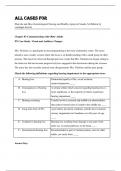All Cases For
Ebersole and Hess Gerontological Nursing and Healthy Aging in Canada, 3rd Edition by
veronique boscart
Chapter 03 Communicating with Older Adults
PN Case Study: Visual and Auditory Changes
Mrs. Nicholas is a participant in day programming at her local community centre. The nurse
attends a once-weekly session where the focus is on health teaching with a small group of older
persons. The nurse has observed through previous weeks that Mrs. Nicholas has begun sitting in
the front row but has become progressively less engaged in the discussions during the sessions.
The nurse has also recently noticed some disagreements Mrs. Nicholas and her peer group.
Match the following definitions regarding hearing impairment to the appropriate term:
A. Hearing loss Diminished quality of life, social isolation,
suspicion/paranoia ____
B. Consequences of hearing A setting within which concern regarding hearing loss is
loss more significant, as the majority of clients experience
hearing impairment ____
C. Hearing screening Usually involves external and middle-ear abnormalities
that reduce transmission of sound to the middle ear ____
D. Long-term Care (LTC) A prevalent, persistent condition, and the most common
sensory impairment in Canadians over 60 years of age.
____
E. Conductive hearing loss Hearing loss resulting from damage to any part of the
inner ear, or neural pathways to the brain ____
F. Sensorineural hearing loss Recommended as part of routine primary care for older
adults, yet rarely done ____
Answer Key:
, A. Hearing loss Diminished quality of life, social isolation,
suspicion/paranoia __B__
B. Consequences of hearing A setting within which concern regarding hearing loss is
loss more significant, as the majority of clients experience
hearing impairment __D__
C. Hearing screening Usually involves external and middle-ear abnormalities
that reduce transmission of sound to the middle ear __E__
D. Long-term Care (LTC) A prevalent, persistent condition, and the most common
sensory impairment in Canadians over 60 years of age.
__A__
E. Conductive hearing loss Hearing loss resulting from damage to any part of the
inner ear, or neural pathways to the brain __F__
F. Sensorineural hearing loss Recommended as part of routine primary care for older
adults, yet rarely done __C__
Rationale:
Hearing loss is a prevalent, persistent condition in older Canadians, and the most common
sensory impairment in Canadians over 60 years of age. Hearing loss increases after the age of 40.
Quality of life and communication are diminished with hearing loss and is associated with many
negative outcomes. Some of these include decreased function, miscommunication, social
isolation, depression, safety risks, and reduced income and employment opportunities. Hearing
impairment may cause an older person to become suspicious, distrustful, or display paranoid
thoughts; inappropriate communication may lead to an erroneous diagnosis of cognitive
impairment. Hearing impairment is underdiagnosed and undertreated in older adults. Screening
impairment and appropriate treatment is considered an essential part of primary care for older
adults, yet it is rarely done. Hearing loss tends to be overlooked as a geriatric syndrome, and is of
particular concern in LTC homes, where the majority of residents are affected. Conductive
hearing loss usually involves the external and middle-ear abnormalities that reduce transmission
of sound to the middle ear, as seen in otosclerosis, infection, perforation of the eardrum, or
fluid/cerumen accumulation. Sensorineural hearing loss results from damage to any part of the
inner ear or neural pathways to the brain, as seen in presbycusis.
, Chapter 8 Nutritional Needs
PN Case Study: Unintentional Weight Loss
Mr. O'Sullivan is a 94-year-old resident at a long-term care (LTC) home. He was admitted to the
LTC home four months ago following hospitalization for pneumonia. He has a history of
Parkinson’s disease, multi-infarct dementia, and hypertension. During care, he grabs at the
stethoscopes and hair of caregivers and will not let go. He grinds his teeth together and makes
repetitive sounds. When in bed, he lays in the fetal position and grabs at covers while grimacing.
He tries to feed himself yet benefits more when fed by assistive personnel. Mr. O'Sullivan is 6’4”
tall (193 cm) and weighs 140 lbs (63.5 kg) with BMI 17.04 kg/m2. Last month, he weighed 150
lbs with BMI 18.26 kg/m2. His blood pressure is 145/88 mm Hg, heart rate 92 beats per minute,
respirations 16 breaths per minute, and temperature 97.3°F (36.3°C). Medications include
carbidopa/levodopa 25 mg/250 mg three times daily; pramipexole 1.5 mg three times daily;
memantine 10 mg twice daily; donepezil 10 mg each evening; clopidogrel 75 mg daily; aspirin
81 mg daily; valsartan 160 mg daily; acetaminophen 500 mg every 4 hours as needed for pain.
Lab work reveals:
Blood urea nitrogen (BUN)/Creatinine: 28 mg/dL / 1.6 mg/dL
Sodium: 145 mEq/L
Potassium: 5.2 mgEq/L
Hemoglobin/Hematocrit: 120 g/L / 0.36 L/L
WBC: 11.0 x 10^9/L
Lymphocytes: 40%
Cholesterol: 140 mg/dL
Albumin: 3.0 g/dL
Prealbumin: 10 mg/dL
Transferrin: 180 mg/dL
TSH: 7.0 µU/mL
Urinalysis: Urine is amber and clear, pH 5.0, nitrite positive and leukocyte esterase trace, RBC
2/hpf, WBC 5/hpf, and bacteria occasional.




